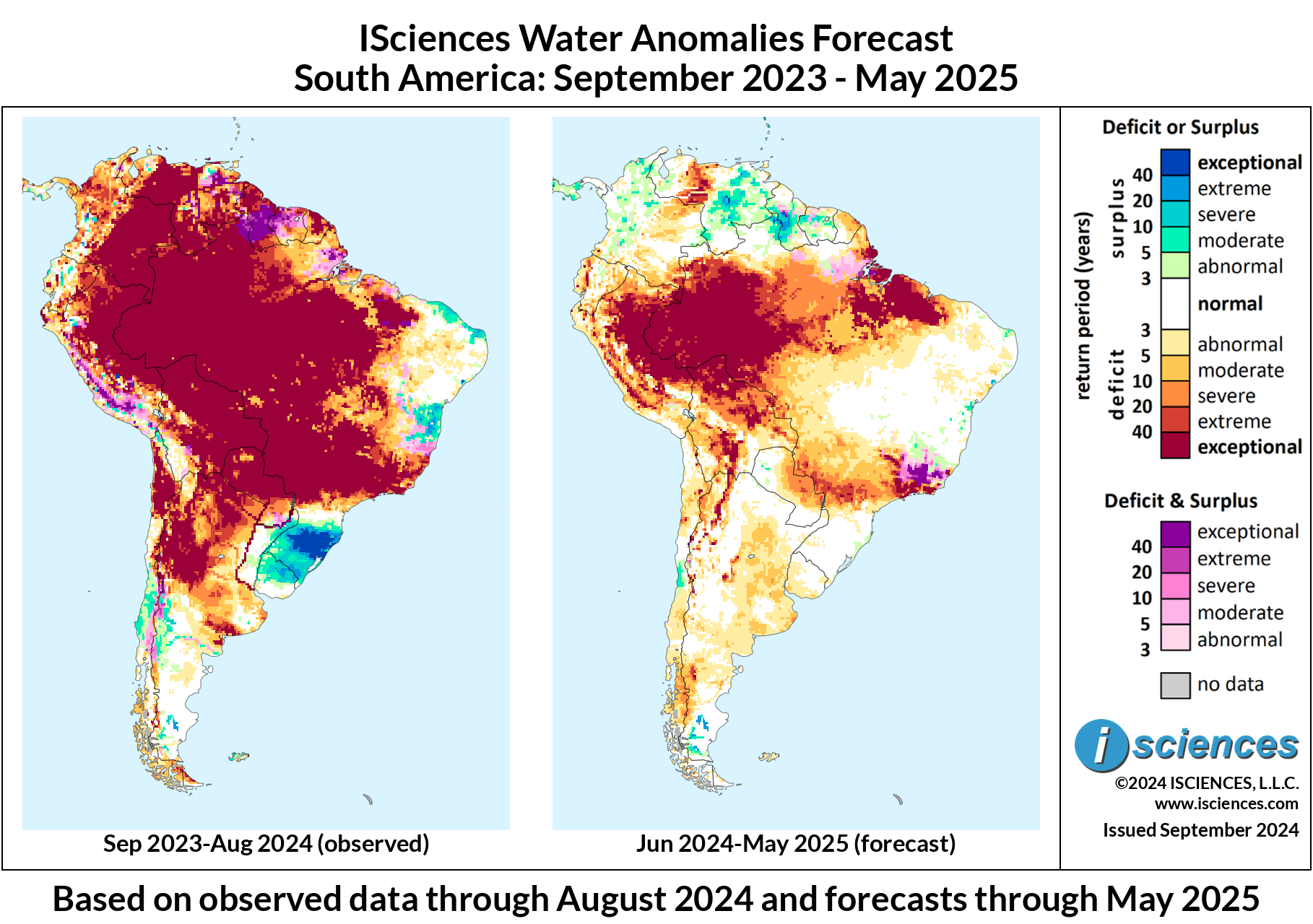South America: Exceptional deficits continue throughout Amazon rainforest
22 September 2024
THE BIG PICTURE
The forecast ending in May 2025 indicates that while exceptional deficits will diminish in some portions of South America, they will remain widespread throughout much of the Amazon Rainforest. Deficits will similarly endure in eastern and southern regions of Brazil, as well as in parts of the Bolivarian Nations.
Severe to exceptional deficits are anticipated in:
Western Venezuela, in central portions of the Los Llanos region.
Western Brazil, primarily throughout the state of Amazonas. These deficits persist further west into eastern to central Peru.
Northeastern Brazil, in coastal regions of the state of Maranhão.
Southern Brazil, in coastal regions of the states of Rio de Janeiro and São Paulo.
Northern Bolivia, throughout the Vida Silvestre Amazónica Manuripi National Reserve, continuing into pockets of central and southern regions of the country. These deficits continue into Argentina’s Northwest and Cuyo regions, as well as the Aysén region of Chile.
Severe to exceptional surpluses are expected in:
The Guianas, in central Guyana and Suriname.
Eastern Venezuela, near the Guri Reservoir.
The 3-month maps (below) show the evolving conditions in more detail.
FORECAST BREAKDOWN
The forecast through November 2024 indicates that exceptional deficits will remain widespread throughout portions of Brazil’s Amazonas state, as well as coastal regions of Para, Maranhao, Piaui, and Ceara. Severe to exceptional deficits will remain similarly widespread throughout northern Venezuela, Peru, and eastern Bolivia. Exceptional deficits are expected to lessen in intensity in central Colombia, becoming severe to extreme deficits. Deficits will downgrade in southern Brazil and eastern Paraguay, becoming severe anomalies. Northern Chile, particularly in the Antofagasta region, will observe an emergence of exceptional deficits.
From December through February 2025, most extreme to exceptional deficits in northern and northwestern South America are expected to diminish. An isolated pocket of severe to extreme deficit is expected to continue in central regions of the Brazilian state of Amazonas. Some severe deficits may continue in areas of central Venezuela, southern Chile, and southwestern Argentina.
The forecast for the final months – March through May 2025 – indicates that the remaining deficits in Brazil will diminish, with severe to extreme surpluses emerging in northwestern Brazil. Moderate surplus will emerge throughout Colombia and southern Venezuela.
Please note that WSIM forecast skill declines with longer lead times.
IMPACTS
As 59% of Brazil is currently water stressed, a significant drought has caused the Sao Paulo River to turn emerald green. The color change is due to an algae bloom caused by significantly lowered water levels. The same day as the algae changed color of the river, air quality in the country reached “very poor” levels due to frequent wildfires dispersing smoke and pollutants into the air. For two consecutive days, the smoke caused 21 million residents to breathe the “second-most polluted air in the world.”
Almost all major rivers in the Amazon have registered their lowest levels in history, and researchers have stated that the outlook for the following months will continue to break records. Currently, the Madeira River reached 31 inches on September 9th – 13 inches below the previous record registered in October 2023. On the same day, the Purus river measured 24.6 feet, which is over 7 feet lower than the previous record. The low levels have caused concern in Manaus, as they are expected to affect prices of products through the city’s harbor. Some Indigenous communities have been isolated by the low river levels, as it significantly reduces water navigability.
As of September 14th, authorities have confirmed that over 50,000 wildfires are currently active throughout Brazil. The regions most heavily affected include the Amazon, Cerrado, and the Pantanal. Additionally, about 60% of all the fires burning throughout South America are reportedly happening in Brazil. A third of these fires are thought to be caused by human activity, primarily stemming from clearing land for agricultural purposes. Deforestation and drought are worsening the widespread dry conditions.
NOTE ON ADMINISTRATIVE BOUNDARIES
There are numerous regions around the world where country borders are contested. ISciences depicts country boundaries on these maps solely to provide some geographic context. The boundaries are nominal, not legal, descriptions of each entity. The use of these boundaries does not imply any judgement on the legal status of any territory, or any endorsement or acceptance of disputed boundaries on the part of ISciences or our data providers.
Subscribe to our monthly Water Watch List
Search blog categories
- *Precip/Temp Outlooks 101
- *Press Releases 1
- *Special Topics 21
- *Water Watch Lists 121
- Africa 130
- Australia & New Zealand 114
- Canada 116
- Central Asia & Russia 114
- East Asia 115
- Europe 121
- Impact Highlights 1
- Mexico & C. Amer. & Carib 119
- Middle East 124
- Proof Point 2
- South America 130
- South Asia 120
- Southeast Asia & Pacific 123
- United States 120
Search blog tags


